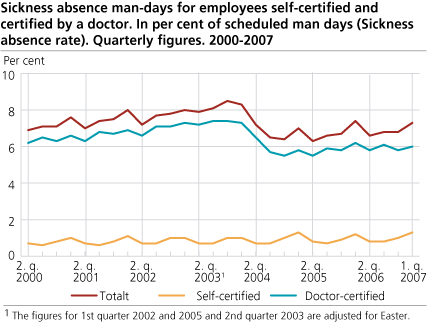Content
Published:
This is an archived release.
Slight decrease in the sickness absence
The sickness absence decreased from 7.4 per cent in the first quarter of 2006 to 7.3 per cent in the first quarter of 2007. This correspond to a decrease of 1 per cent. Absence certified by a doctor decreased from 6.2 to 6.0 per cent, while the self-certified absence increased from 1.2 to 1.3 per cent.
For men the sickness absence dropped from 5.9 to 5.8 per cent, while it remained steady at 9.2 per cent for women.
The sickness absence the first quarter of 2007 was 3.5 per cent lower than it was in the first quarter of 2001, the year when the agreement on an inclusive labour market was implemented.
Strongest decrease in transport and communication
Amongst the larger industries, the decrease in sickness absence was largest in transport and communication and construction with 3.5 per cent. Real estate and business activities and financial intermediation rose the most with 2.6 and 1.9 per cent respectively.
Strongest decrease in Sør-Trøndelag county
The sickness absence declined the most in Sør-Trøndelag followed by Rogaland by 4.3 and 3.9 per cent respectively. Buskerud and Nordland had the largest growths with 3.9 per cent and 2.7 per cent respectively.
The sickness absence level was still lowest in Rogaland with 5.8 per cent and highest in Finnmark with 9.5 per cent.
Decreasing proportion of long-lasting absences
From the first quarter of 2006 to the first quarter of 2007 the proportion of doctor certified sickness absence lasting more than 31 days within this quarter, went down from 58.2 to 55.6 per cent. The proportion of self-certified sickness absence compared to the total sickness absence (self-certified and doctor-certified) rose during the same period from 16.1 per cent to 17.2 per cent.
The increase in the proportion of self-certified sickness absence and doctor certified sickness absence lasting shorter then 31 days within the quarter, may be as a result of this quarter's flu season.
Strongest rise in Central government
The sickness absence fell in all of the sectors except Central government (including the state hospitals), which grew by 0,6 per cent. The sickness absence in local government dropped the most by 1.5 per cent. In the private sector the sickness absence fell by 1.0 per cent.
Within Central government, the education industry (universities and colleges) rose the most by 1.9 per cent. Within health-care (mainly the state hospitals) the sickness absence increased by 0.7 per cent. Within local government, the public administration industry had the strongest decrease by 3.8 per cent.
The level of the sickness absence in local government is still the highest with 9.2 per cent, while private sector had the lowest in with 6.8 per cent
Decline in most of the age groups
Within the largest age groups 16-66 years, the doctor certified sickness absence increased the most in the age group 20-24 years by 3.2 percent and in the age groups 30-34 years by 0.4 per cent. Otherwise the sickness absence decreased. The age group 60-64 years had the largest decrease by 4.0 per cent.
Females had the strongest decrease in the age group 55-59 years by 4.6 per cent and for males the age group 50-54 years had the largest fall by 5.5 per cent.
The results are based on data on sickness absence certified by a doctor, as the survey on self-certified absence does not contain data on sickness absence by age.
The sickness absence rate measures the proportion of scheduled man-days lost due to own sickness. The statistics do not cover self-employed persons.
The sickness absence statistics are produced in cooperation with the Norwegian Employment and Welfare Organisation (NAV). For more information from NAV, contact
Tables:
- Table 1 Sickness absence man-days for employees self-certified and certified by a doctor. In per cent of scheduled man-days (Sickness absence rate). Quarterly figures. 2000-2007
- Table 2 Sickness absence man-days for employees self-certified and certified by a doctor, by sex. In per cent of scheduled man-days (Sickness absence rate). 2000-2007. Quarterly figures
- Table 3 Sickness absence man-days for employees self-certified and certified by a doctor, by industry and type of sickness absence. In per cent of scheduled man days (Sickness absence rate). 2000-2007. Quarterly figures
- Table 28 Sickness absence, by type of absence(self-certified or doctor-certified) and duration within the quarter
- Table 33 Change in per cent of the sickness absence rate for employees self-certified and certified by a doctor, by industry and type of sickness absence. 2000-2007. Quarterly changes
Contact
-
Arbeidsmarked og lønn
E-mail: arbeidsmarked@ssb.no
-
Unn H. Høydahl
E-mail: unnh.hoydahl@ssb.no
tel.: (+47) 40 90 23 77

